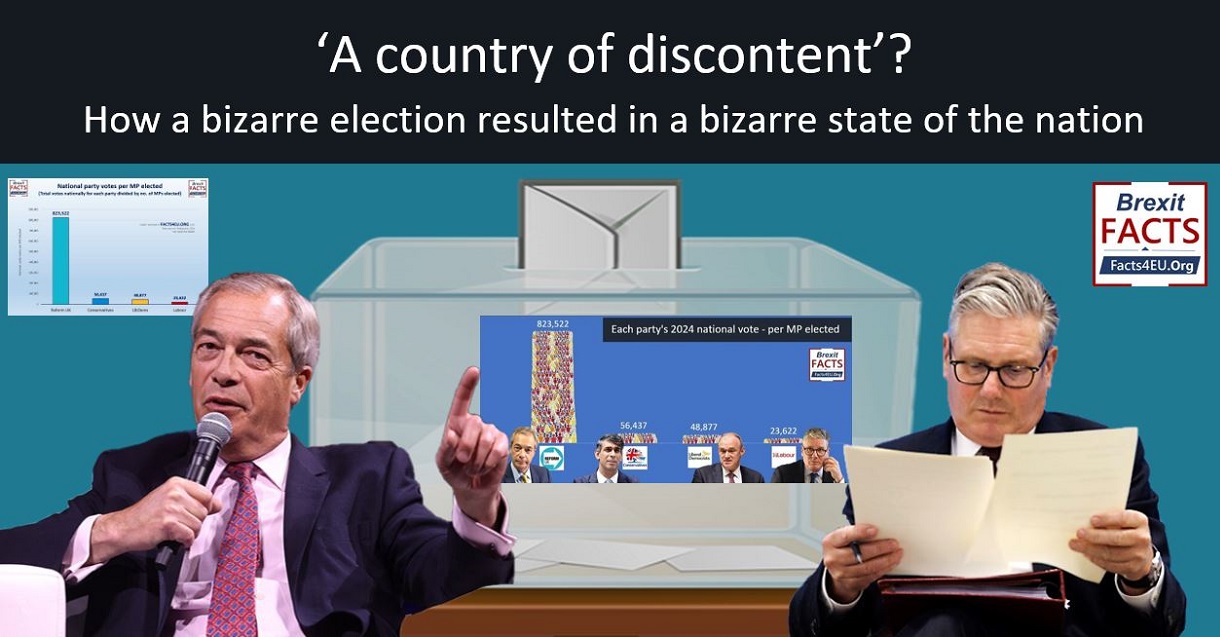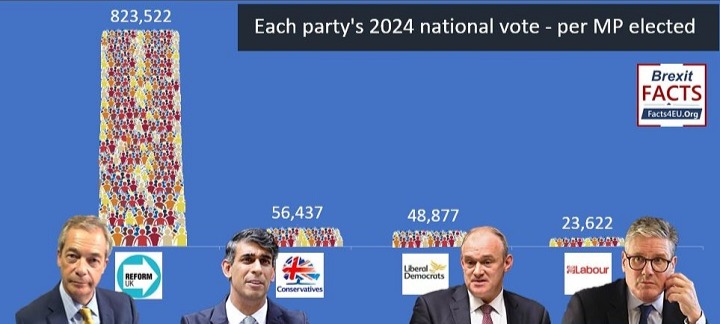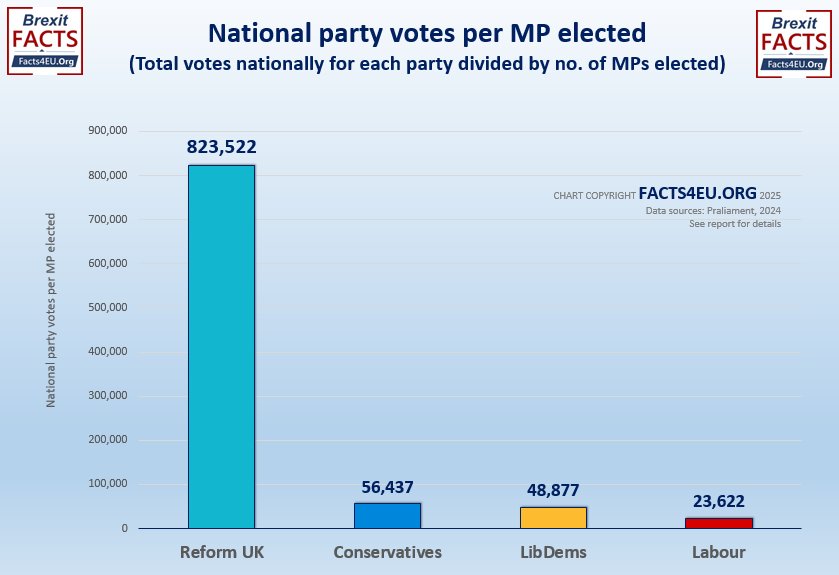‘A country of discontent’? How a bizarre election resulted in a bizarre state of the nation
Starmer’s massive majority in Parliament yet massive minority in the country – what happened?
Montage © Facts4EU.Org 2025, Nigel Farage picture attribution: Gage Skidmore
A unique Facts4EU look at one very peculiar effect of the election on the country today
No-one ever analyses an election the way we are about to – probably because we had all never seen one quite like it.
Yesterday we published an article based on a report about the 2024 general election which we produced last year but one it seems many people had not read – possibly because of the holiday season. Today we go one step further with the analysis of the result and place it in the context of a government which has become rapidly unpopular with a larger number of people than might have been expected.
In this analysis we look at a consequence of our ‘first past the post’ (FPTP) system which is seldom considered. Everyone knows that this produces results where the government almost never wins based on a majority of the votes counted. Instead it is the party that wins a majority of the seats that forms the government. Very occasionally this means forming a coalition with another party, as happened in the 2010 election with the Cons-LibDem coalition government of David Cameron.
Normally, though, as happened in 2024, one party secures more than 50% of the seats. In Labour’s case it won far more than that. It did so, however, with the second-lowest turnout in 100 years and with one of the smallest percentage of votes ever seen for a governing party.
We therefore analysed the result based on the unusual measure of ‘national party votes per MP elected’. This is a simple calculation which takes the total number of votes cast nationally for each party and then divides by the number of MPs they ended up with.
The biggest victim in the 2024 general election was Reform UK and the biggest beneficiary was Sir Keir Starmer’s Labour Party, as we shall show.
Brexit Facts4EU.Org Summary
The national vote and individual MPs
Our figures below provide the overall number of votes for each party at national level, divided by the overall number of their MPs who were elected. We refer to these as ‘National party votes, per MP’. This is not an official term but it describes what we are trying to show.
As everyone knows, we live in a parliamentary representative democracy. We vote for a candidate to represent us in our own constituency. Allegedly we don’t vote for a party, although in reality many do, because many of us wouldn’t know our local MP from Adam or Eve.
© Brexit Facts4EU.Org 2025 - click to enlarge
[Data source : Facts4EU analysis based on the reports to Parliament by the Returning Officer for each constituency.]
PLEASE NOTE : We are only including the four main UK national political parties. We have not included the Greens as they are now three separate parties in England & Wales, Scotland, and N.I..
A graphical representation of this situation
Seen behind each party leader below is an illustration of the numbers of national voters for their party, per seat won. This shows graphically how certain parties – especially Labour – won a very large number of seats with a disproportionately low number of votes nationally.
© Brexit Facts4EU.Org 2025
For those who prefer our more conventional charts...
© Brexit Facts4EU.Org 2025 - Click to enlarge
[Data source : Facts4EU analysis based on the reports to Parliament by the Returning Officer for each constituency.]
Huge imbalance between national votes cast and seats – Reform UK versus the rest
Our table in yesterday's report shows that Reform UK came third in the general election, beating the LibDems in terms of number of votes. Despite this, Reform only won 5 seats whereas the LibDems ended up with an astonishing 72.
The reason, as everyone knows, is that under the ‘first-past-the-post’ system in the UK, there are no prizes for coming second. Seats are won only for coming first in the ballot. Whilst being ostensibly a national party, the LibDems tend to concentrate their fire-power on around a third of the 650 constituencies.
On a purely national level, here are the ratios for the relative 'values' of the votes of the three other parties, per MP elected, against those of Reform UK:-
- Conservatives : 15 times
- LibDems : 17 times
- Labour : 35 times
The second places
In the election on 04 July 2024, Reform came first five times and second 98 times. Contrary to most people’s perceptions, they ran second to the following number of winning candidates from Labour, the Conservatives, and the LibDems, respectively.
Brexit Facts4EU.Org Summary
Winning parties in constituencies in which Reform came second
- Labour : 89 constituencies
- Conservatives : 9 constituencies
- LibDems : 0
[Data source : Facts4EU analysis based on the reports to Parliament by the Returning Officer for each constituency.]
Observations
Facts4EU.Org remains non-partisan. We comment on individual parties only insofar as it affects our core aims of independence, sovereignty, democracy and freedoms.
Furthermore, this is not an advocacy piece for proportional representation. Various forms of this are widely used across the EU and they typically result in unstable governments and a lot of time spent by the leaders of the majority parties on attempting to make policies and horse-trade with their their coalition partners to persuade them to accept them, instead of governing the country.
A year ago we expressed concern about the democratic deficit in this particularly unusual election result in the UK. Unfortunately there seems to have been no recognition from Sir Keir of the low level of support he started out with and all that matters is that he has the majority required in the House of Commons to pass whatever he likes. Unsurprisingly this is causing increasing disquiet amongst large parts of the population.
In our report above, we have highlighted what many will see as a gross injustice. More people voted for Reform UK than voted for the LibDems, and yet the LibDem voters are represented in Parliament by nearly 15 times the number of MPs which Reform UK has.
The imbalance in this case is so extreme it cannot be good for social cohesion, respect for the laws of the land, and belief in our democratic systems.
The reasons Reform UK did not win more seats isn't only down to FPTP
We should say at this point that Reform UK were always going to struggle from the moment an early, snap election was called by Rishi Sunak. Like everyone else, they had been preparing for a November election when they would have had more good candidates selected and more in the way of local party workers on the ground. Their fund-raising was also still at an early stage.
As things stand, this is looking unlikely to be repeated at the next election.
Please, please help us to carry on our vital work in defence of independence, sovereignty, democracy and freedom by donating today. Thank you.
[ Sources: Facts4EU analysis based on the reports to Parliament by the Returning Officer for each constituency | House of Commons Library ] Politicians and journalists can contact us for details, as ever.
Brexit Facts4EU.Org, Tues 19 Aug 202<5/p>
Click here to go to our news headlines
Please scroll down to COMMENT on the above article.
And don't forget actually to post your message after you have previewed it!
Since before the EU Referendum, Brexit Facts4EU.Org
has been the most prolific researcher and publisher of Brexit facts in the world.
Supported by MPs, MEPs, & other groups, our work has impact.
We think facts matter. Please donate today, so that we can continue to ensure a clean Brexit is finally delivered.
Paypal Users Only - Choose amount first
Quick One-off
Monthly






Something to say about this? Scroll down for reader comments